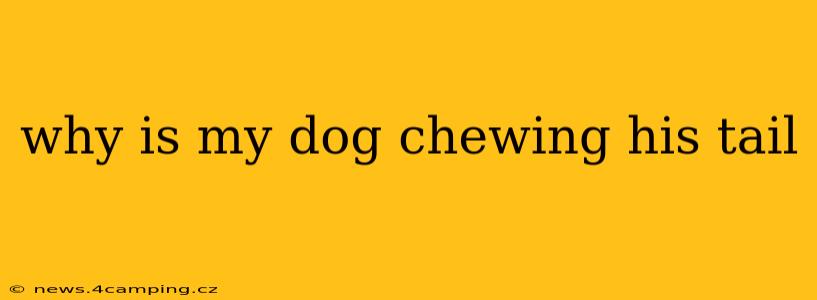Why Is My Dog Chewing His Tail? A Comprehensive Guide
Many dog owners find themselves worried when their canine companion starts excessively chewing their tail. This behavior, while seemingly innocuous, can indicate a variety of underlying issues, ranging from simple boredom to serious medical conditions. Understanding the potential causes is crucial to addressing the problem and ensuring your dog's well-being. This guide will explore the common reasons behind tail chewing in dogs, providing insights into diagnosis and effective solutions.
Is it Allergies or a Skin Condition?
One of the most common reasons for tail chewing is an underlying skin irritation. Allergies, whether environmental (pollen, dust mites) or food-related, can cause intense itching and discomfort, prompting your dog to chew at their tail for relief. Fleas, ticks, and other parasites can also lead to similar reactions. Skin conditions like dermatitis or hot spots can also manifest as intense itching, focused on the tail. Careful observation of your dog's skin, particularly around the tail, is crucial. Look for redness, inflammation, scabs, or any signs of parasites. If you notice these symptoms, a veterinary examination is essential for proper diagnosis and treatment.
Could it be Anxiety or Boredom?
Dogs, like humans, can suffer from anxiety. Separation anxiety, for instance, can manifest as destructive behaviors, including tail chewing. Boredom is another significant factor. A dog lacking sufficient mental and physical stimulation might resort to self-soothing behaviors, such as chewing their tail, to alleviate boredom and pent-up energy. Consider your dog's daily routine. Do they get enough exercise, playtime, and mental stimulation? If not, adjusting their routine to incorporate more engaging activities could significantly improve their behavior.
Is Pain the Culprit?
Pain, whether from an injury or a medical condition, can also lead to tail chewing. A tail injury, such as a fracture, sprain, or bruise, can cause discomfort and inflammation, leading your dog to lick or chew the area. Other medical conditions, such as anal gland problems or infections, can also cause pain and discomfort near the tail, indirectly causing tail chewing. If your dog shows signs of pain or limping, it's crucial to consult a vet immediately.
What about Psychological Factors?
In some cases, tail chewing can be a manifestation of a deeper psychological issue. Compulsive disorders, similar to obsessive-compulsive disorder (OCD) in humans, can lead to repetitive, self-destructive behaviors, including tail chewing. These cases often require specialized veterinary behavioral therapy. Identifying underlying psychological factors often requires observing your dog's behavior in detail and seeking professional veterinary guidance.
How Can I Stop My Dog from Chewing His Tail?
Stopping tail chewing requires a multi-pronged approach. First, a veterinary visit is crucial to rule out any underlying medical or allergic conditions. Once a diagnosis is made, treatment can address the root cause. This might involve medication for allergies or infections, pain management, or even surgery in severe cases.
Alongside veterinary treatment, consider:
- Providing adequate mental and physical stimulation: Regular exercise, playtime, and puzzle toys can help alleviate boredom and anxiety.
- Creating a calming environment: A quiet and comfortable space can help reduce stress.
- Using deterrents: Bitter apple sprays or Elizabethan collars (commonly known as "E-collars") can prevent your dog from reaching their tail.
- Behavioral modification techniques: Positive reinforcement training can help redirect your dog's attention away from their tail.
Tail chewing in dogs is a complex issue. Addressing it effectively requires identifying the underlying cause through a thorough examination by a veterinarian and implementing appropriate treatment and behavioral modification strategies. Remember that patience and consistency are crucial for success. With careful observation and professional guidance, you can help your dog overcome this behavior and live a happier, healthier life.
